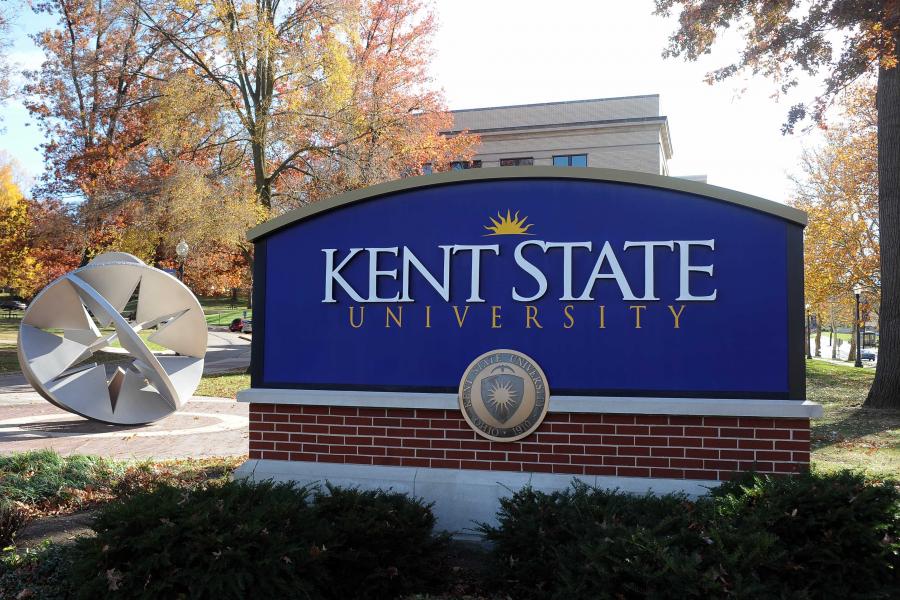Department of Physics

Department of Energy Selects Kent State Nuclear Physics Doctoral Student for Prestigious Research Program
Edwin Duckworth, a physics doctoral student in the College of Arts and Sciences at Kent State University, is among 65 students from 29 states recently selected for funding by the Department of Energy’s (DOE) Office of Science Graduate Student Research (SCGSR) program. The program aspires to “address societal challenges at national and international scale.”

New Collaboration to Provide Real-Time Data Exchanges for Astrophysicists
What happens when two neutron stars collide? What extreme densities and temperatures are reached? What new states of matter exist within the core of a neutron star? One Kent State College of Arts and Sciences theoretical astrophysicist, Veronica Dexheimer, associate professor in the Department of Physics, is diving headfirst into these questions as a co-principal investigator collaborating with her peers at multiple institutions on a recently funded cyberinfrastructure research grant project.

DNA & NAS: Kent State Professors Publish Comprehensive Research Article
It doesn’t take a scientist to understand the importance of DNA, as it acts as the very foundation for the existence of any living organism. However, it does take one to produce publications involving smectic liquid crystal ordering in dense solutions of “gapped” DNA duplexes. Samuel Sprunt, Ph.D…
Physics Professor Awarded NSF Grant that Provides Research Opportunities for Interdisciplinary and Minority Students
The National Science Foundation (NSF) recently awarded a $300,000 grant to Thorsten-Lars Schmidt, Ph.D., to develop molecular tools that allow researchers to study membrane proteins. Schmidt, assistant professor of the Department of Physics in the College of Arts & Sciences, began devel…
Third Generation Honors College Student Earns Full Ride to Georgia Institute of Technology For Graduate Program
Jacob Grant, Kent State University Honors College student, is a senior aerospace engineering major with a minor in physics. Grant graduated from Edison High School in Milan, OH in 2017. After a late medical disqualification from the Air Force Academy, he chose to attend Kent State University. Grant is a third generation Kent State University Honors College student. His grandmother studied Spanish at Kent State and his mother studied education. Both were members of the Honors College.

Kent State Receives More Than $3 Million In Grants From National Science Foundation
Kent State University has recently received a flurry of grants totaling more than $3 million in funding from the National Science Foundation (NSF), which will support research and innovation in a wide range of fields within the College of Arts and Sciences.

Nuclear Physicist Tracks Rare Collided Particles to Better Understand Big Bang
Congratulations are in order for Sooraj Radhakrishnan, Ph.D., a postdoctoral fellow in the Kent State University College of Arts and Sciences’ Department of Physics who performs research in experimental nuclear physics. His data analysis of some rare particles called “charm quarks” that may have existed in the first microsecond of the Big Bang, the emerging point of our universe, was highlighted in a recent issue of the U.S. Department of Energy’s (DOE) Science Bulletin.

Kent State Physics Professor Elected as 2020 Fellow of Prestigious Scientific Society
Jonathan V. Selinger, professor and Ohio Eminent Scholar in Kent State University’s Department of Physics, in the College of Arts and Sciences, and the Advanced Materials and Liquid Crystal Institute, has been elected a Fellow of the American Association for the Advancement of Science (AAAS), the world’s largest general scientific society and publisher of the journal Science.

Kent State Physics Professor Elected as 2020 Fellow of Prestigious Scientific Society
Jonathan V. Selinger, professor and Ohio Eminent Scholar in Kent State University’s Department of Physics, in the College of Arts and Sciences, and the Advanced Materials and Liquid Crystal Institute, has been elected a Fellow of the American Association for the Advancement of Science (AAAS), the world’s largest general scientific society and publisher of the journal Science.